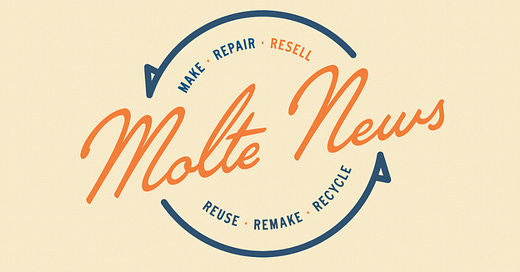I had a front row seat to an amazing conversation recently. As part of the type of work I do related to take back, recycling and reverse logistics, I try to help move unwanted materials to recyclers who are willing to take them.
In this case, it was a conversation between a textile collector/sorter and a textile recycler. The collector collects a majority of post-consumer clothing and a minority of pre-consumer clothing (unsold clothes). They sort everything for highest reuse value, and after pulling out everything that can be resold, there is still a large amount left over, usually about 50% of their total volume, that cannot be reused as clothes, but should not be thrown away. These items can become feed stock for textile recycling, at least for certain streams of fiber recycling, like cotton, cotton denim, and wool. The collector/sorter is smart and has sorted this remaining 50% by fiber to keep it at its highest value. (Also important to understand, collector/sorters pay to have things landfilled, so it is also in their best interest to find other solutions beyond landfill or incineration.)
The recycler handles all kinds of textiles and shreds them into different qualities to become yarn, new textiles and other products like insulation. They know how to process and handle cotton versus cotton denim versus wool versus polyester, etc..
The conversation was really hinging on one thing: could these two parties come to a financial agreement that worked for both? The collector/sorter is looking to offload their sorted goods, and the recycler is looking to acquire these types of goods, but it all comes down to money.
If you have followed this newsletter for a while, you know that textile feedstock for recycling is a penny’s game. Each pound of sorted material is usually worth somewhere between zero and ten cents with some exceptions and higher prices for pre treated materials (detrimmed) and more valuable materials (like cashmere).
There’s actually a third-party in this conversation: freight companies. The cost of moving large quantities of anything from one place to another can be prohibitively expensive, and at the very least usually eats up a significant chunk of profits in my experience of textile recycling. In order to get the most value from the cost of freight, you want to send a full truckload, which is usually somewhere between 30,000-40,000 pounds. Sidenote: this is a huge factor at play when talking about infrastructure for circular economy and is an important reason to develop regional operations.
So, with all of that context set, the conversation I was observing was really a negotiation about the profitability of a truckload of sorted, post-consumer textile recycling feed stock. The collector/sorter and the recycler basically made a puzzle out of the container load, determining which high and low value items should be included and in what volumes in order to cover freight and give everyone a little profit. They did come to a resolution together, and it could be the beginning of a consistent feedstock supply for incremental, textile recycling operations.
We can talk high-level about circular economy, what’s needed and how it works, but for me, it’s really these types of conversations between individuals that highlight how we are going to get this done.
Cynthia
cynthia@moltevolte.com
www.moltevolte.com




It's nice to see and on-the-ground illustration! thanks Cynthia!!